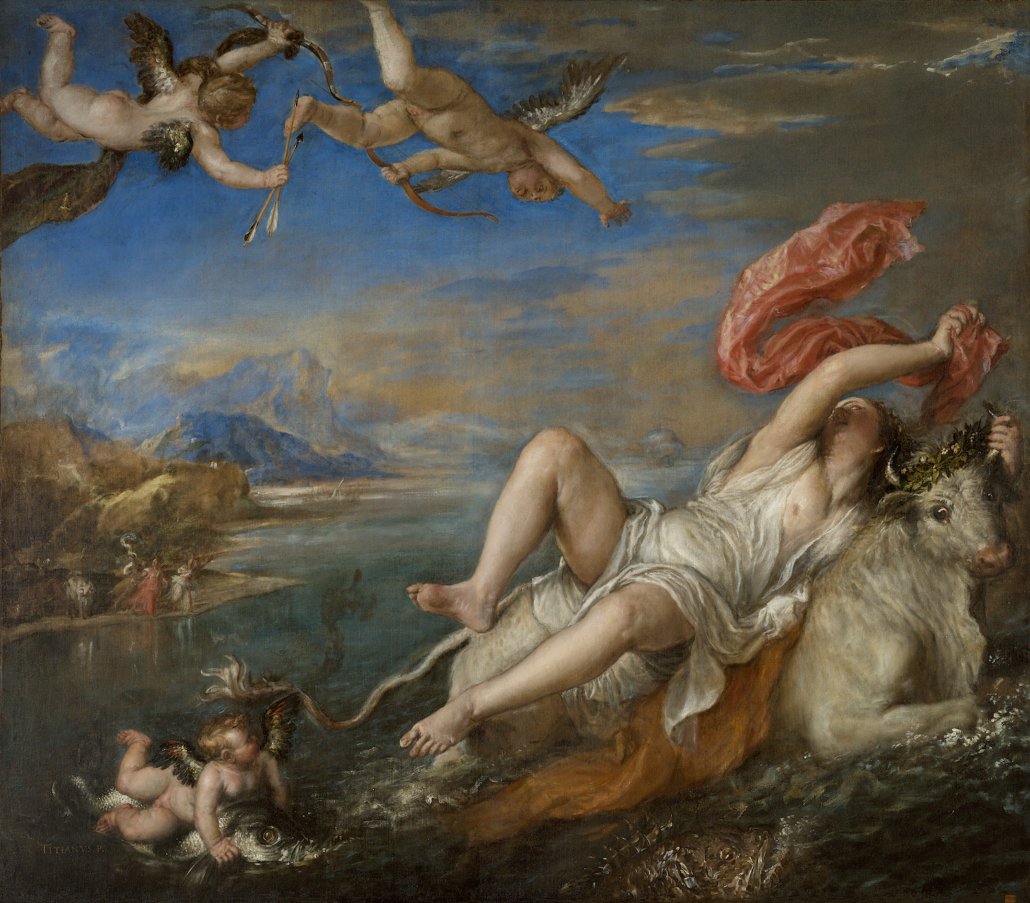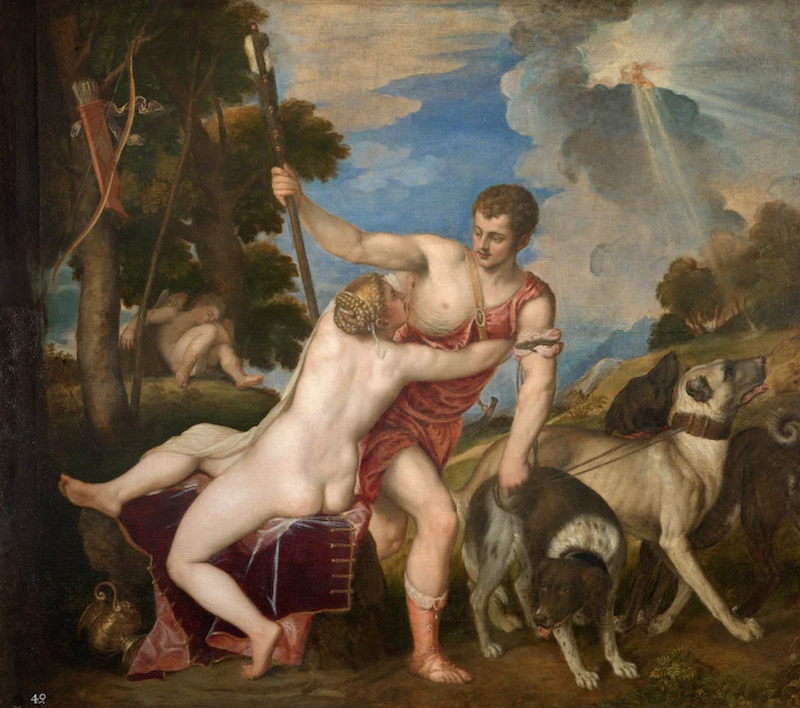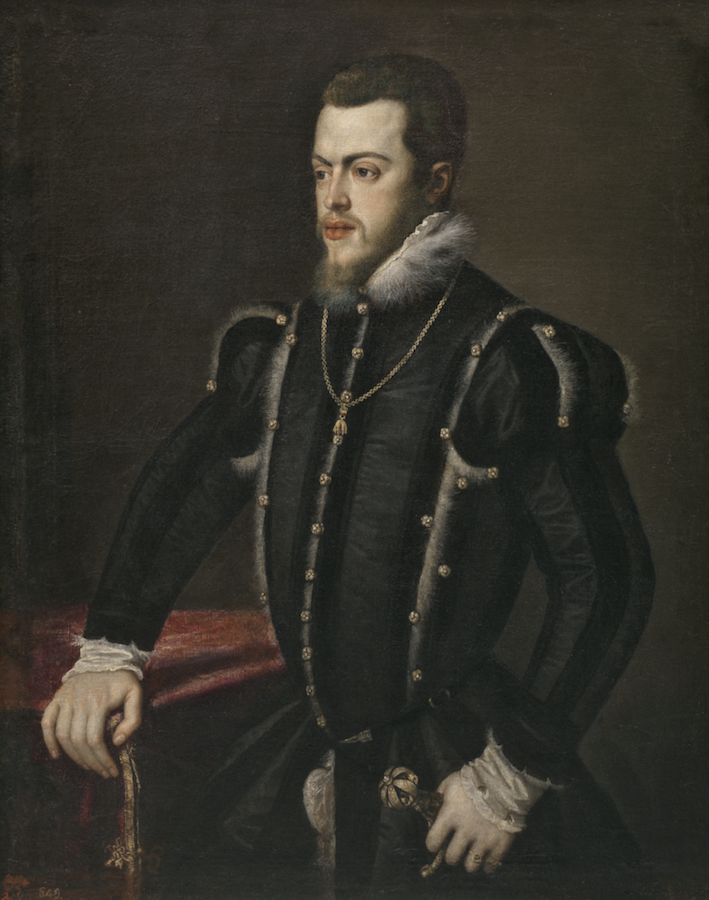
BOSTON – For the first time in more than four centuries, the epic series of mythological paintings by Titian, one of the most celebrated artists of the Renaissance, is reunited in Titian: Women, Myth & Power. The exhibition — jointly organized by The National Gallery, London; National Galleries of Scotland, Edinburgh; Museo Nacional del Prado, Madrid; and the Isabella Stewart Gardner Museum (ISGM )— brings together the Gardner’s masterpiece, The Rape of Europa, with its companion paintings from Spain, England, and Scotland. Titian: Women, Myth & Power makes its final, and only US, stop at the ISGM from August 12, 2021, through January 2, 2022.
“We are honored to partner with The National Gallery (London), National Galleries of Scotland, and Museo Nacional del Prado on this historic reunion of Titian masterworks,” says Peggy Fogelman, the ISGM’s Norma Jean Calderwood Director. “One hundred twenty-five years ago, The Rape of Europa became the centerpiece of Isabella’s collection and strengthened her resolve to create a world-class museum. Isabella would be delighted to witness her masterpiece reunited at the Gardner Museum with its partners, as well as the conversation and creativity it still inspires today.”
In 1550, Prince Philip, the future king of Spain and world’s most powerful ruler, commissioned Titian (Italian, about 1488–1576), the most famous artist in Europe, to create a group of paintings. Inspired by the ancient Roman poet Ovid’s Metamorphoses, Titian produced six large-scale canvases depicting stories from classical mythology. Calling the pictures “poesie” or “painted poems,” Titian expertly captured moments of intense drama, exploring themes of power, desire, and even death. The paintings, considered Titian’s tour de force, are among the most original visual interpretations of these classical myths, touchstones in European art history, and some of the greatest Renaissance works ever made.
Titian produced the boldly executed paintings in Venice over a decade (from 1551–62) and sent them to Philip (who became King Philip II in 1556), who ultimately displayed them at the Alcazar, his royal palace in Madrid, the world’s political and economic capital. Following Philip’s death and over several centuries, the paintings changed hands, landing in collections throughout Europe and the United States. Today, the works belong to the following institutions: Perseus and Andromeda, The Wallace Collection, UK; Danaë, The Wellington Collection, UK; Venus and Adonis (the only work that remained in Spain), Museo Nacional del Prado, Madrid; and Diana and Actaeon and Diana and Callisto, two paintings jointly owned by The National Gallery, London, and National Galleries of Scotland, Edinburgh. However, the sixth and final work in the series, The Rape of Europa, took a different path, ultimately finding its home in America.

At the end of the 19th century, determined to acquire a Venetian masterpiece of global significance, Isabella Stewart Gardner, with the assistance of her art advisor, Bernard Berenson, purchased the picture from an English aristocrat, setting a record for the highest price paid for a painting in the United States. Titian: Women, Myth & Power represents the first time that Europa has left the Museum since Isabella acquired it, and the exhibition at the Gardner coincides with the one hundred and twenty-fifth anniversary of the work’s arrival in Boston in August 1896. (An animated map, created by The National Gallery and on view at the exhibition’s entrance, illustrates the travels of the six poesie paintings over the course of nearly five hundred years.)
“Titian’s Europa is widely regarded as the most important Renaissance painting in the United States, and we are thrilled to see it return home as part of this unprecedented exhibition,” says Nathaniel Silver, exhibition curator and William and Lia Poorvu Curator of the Collection at the Gardner.
The Rape of Europa (1559–62), which the artist characterized as the crowning achievement of his poesie series in a letter to Philip II, depicts the legendary founding story of Europe. The painting showcases Titian’s ability to capture raw human emotion depicting Europa at the moment of her abduction, waving a swath of red fabric while clinging to Jupiter, who has transformed himself into a white bull. Two putti armed with bows tumble overhead while another riding a dolphin follows the kidnapped princess to her imminent fate. Painted at the peak of his career, Titian interprets Europa’s entire story, an ancient Roman fable of lust and tragedy, within a single canvas filled with compositional richness.
Titian conceived his series of mythological tales as pendant pairs which is how they will be displayed in the Gardner’s installation on view in the Museum’s Hostetter Gallery. Rape of Europa will be joined by Perseus and Andromeda from London’s Wallace Collection, which has never before lent a work of art to the United States. This is also the first time that Diana and Actaeon and Diana and Callisto (National Gallery, London / National Galleries of Scotland, Edinburgh) have left Europe. To further highlight the connections between the six paintings, they will be displayed in identical frames designed and built by the National Gallery Frames Department (under the leadership of Peter Schade)—cut, carved, and gilded based on a sixteenth century Venetian original. (It is possible to watch a film on that process here.)
Two royal portraits complete Titian: Women, Myth & Power on the final wall of the gallery. Portrait of Philip II (Titian, 1549–50, Museo Nacional del Prado, Madrid), Titian’s greatest patron, seems to hold court over the works he commissioned. This powerful picture of the would-be king, on loan from the Museo Nacional del Prado, was painted by Titian shortly after they first met in Milan in 1548 when Titian was around sixty and the young prince was 21 years old. Hanging next to Philip is a portrait of his wife, Mary I, Queen of England (Antonius Mor and Workshop, 1554) from the Isabella Stewart Gardner Museum’s own collection, painted the year of her marriage to Philip.

Other treasures from Gardner’s collection tell the story of the founder’s acquisition of The Rape of Europa and how it began to inspire American artists. Correspondence on view in the exhibition includes letters to Isabella from: writer Henry James, a frequent guest of Isabella and her husband Jack when in Venice; art advisor Bernard Berenson, who facilitated many of Isabella’s art acquisitions; and artist Paul Manship, whose bronze cast of the Rape of Europa (1917), inspired by Titian’s painting, is also on display.
The exhibition in Boston follows The National Gallery (UK) and most recently, the Museo Nacional del Prado. (Timing was delayed at all venues, and the showing in Edinburgh cancelled, due to the Covid-19 pandemic.) A Titian catalogue, published by the National Gallery, features essays from an international team of scholars, curators, and conservators. Additionally, Titian’s Rape of Europa, a publication spotlighting the Gardner’s masterpiece, was written by Nathaniel Silver in conjunction with the exhibition. These books, as well as other Titian-related publications and merchandise—including a limited edition Barbara Kruger tote bag—are available in the Museum’s shop, Gift at the Gardner, and online at gift.gardnermuseum.org.
Reconsidering Titian: Contemporary Perspectives
In each of Titian’s poesie pictures, the female subjects and the fates that befall them, especially at the hands of men, raise a range of questions about gender, power, identity, sexuality, and violence in the age of the Renaissance and today. In conjunction with Titian: Women, Myth & Power, the Gardner Museum has collaborated with artists and scholars to respond to Titian’s paintings, using the works as catalysts to provoke ideas, inspire creativity, and foster conversation.
Contemporary artists—Barbara Kruger, and Mary Reid Kelley and Patrick Kelley—were commissioned by the Museum to create new works in reaction to Titian’s paintings. Body Language (2021) by Barbara Kruger was made by reworking details from Diana and Actaeon (1559) and layering them with text. For decades, Kruger has deployed the graphic form of public art to address questions of oppression and abuse of power. Here the image of two entwined bodies in a silent nuanced frozen gesture of power and submission, invites us to reconsider the representation of women, power, and sexuality through the ages and to reflect on the art historical concept of the “gaze.” Kruger’s image of these striking figures, overlaid with her signature bold text, is installed on the Anne H. Fitzpatrick Façade adjacent to the Museum’s entrance.
“Looking at myths across the ages with a contemporary lens is a powerful tool to better understand the past and the present. I am so grateful to Barbara Kruger and Mary Reid Kelley and Patrick Kelley for giving us an extraordinary rereading of Titian through the amazing work they have created for this exhibition,“ shares Pieranna Cavalchini, Tom and Lisa Blumenthal Curator of Contemporary Art.
Mary Reid Kelley and Patrick Kelley’s 2021 film, The Rape of Europa, is a biting, witty, and bawdy twenty-first-century response to the scene of sexual violence romanticized in Titian’s 1562 painting of the same title. Their graphically stylized short film combines painting, performance, and Mary Reid Kelley’s distinctive satirical poetry, layered by Patrick Kelley into an episodic fable-like reenactment of stories from classical antiquity that gives Europa a perspective and agency excluded from historical portrayals. Mary plays a wide range of mythical characters trapped between comic and tragic scenarios. The character of Europa is updated from a Phoenician princess to a disgruntled and traumatized young professional coping with the aftermath of violent assault, that resonates with the present-day #MeToo movement. The nine-minute film is on view in the Museum’s Fenway Gallery in the historic Palace, located close to the Museum’s Courtyard which the artists recreated as a backdrop for Europa in their modern mythological take. The Gardner has welcomed artists to live, work, and be inspired by the collection as Artists-in-Residence since 1992, continuing Isabella’s tradition of inviting artists to imagine and create at the Museum.
In addition to these two works of art commissioned in response to Titian: Women, Myth & Power, the Museum has also invited artists and scholars to reconsider the poesie paintings for the present moment, in their own words.
For more information about the exhibition, visit the Isabella Stewart Gardner Museum online.
# # #



